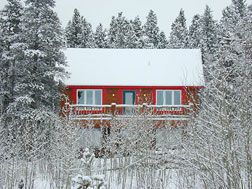
Improvisational Carpentry:
An Interview with artist John Boak
Back in February, we received an email from Colorado artist John Boak saying,
"This is a note to let you know how helpful your
Wood Slicer blades
were in finishing my cabin."
While checking out his website, we became thoroughly intrigued, so Doug Hall, Highland's Educational Director, interviewed John about how he came to build such whimsical yet compelling designs, a process that John calls "improvisational carpentry."
To say that your cabin home is overwhelming is an understatement. It is such a creation of your heart's vision, I think it would be very hard to make it any more personal.
Could you provide details concerning how long the project has taken to reach this point and what may lie ahead?
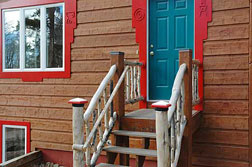 The cabin's drawings were made in the spring of 2004. We poured the foundation in July. The builder finished his portion in December. We began work in the summer, applying finish to the exterior planks. I began my work in the fall, making the aspen railings on site, outdoors. Back in the city I built the exterior window frames. I have been working on it ever since, adding interior wall coverings, floors, window and door trim, cabinets, furniture and fittings. We got our COO (Certificate of Occupation) in 2006. I continue working on interior trim, cabinetry, and furniture. I hope to add a small workshop building, so that I can move the bandsaw out of the cabin.
The cabin's drawings were made in the spring of 2004. We poured the foundation in July. The builder finished his portion in December. We began work in the summer, applying finish to the exterior planks. I began my work in the fall, making the aspen railings on site, outdoors. Back in the city I built the exterior window frames. I have been working on it ever since, adding interior wall coverings, floors, window and door trim, cabinets, furniture and fittings. We got our COO (Certificate of Occupation) in 2006. I continue working on interior trim, cabinetry, and furniture. I hope to add a small workshop building, so that I can move the bandsaw out of the cabin.
Obviously there are many influences that you allowed to be part of the whole, but where did the idea to undertake such a deeply-reaching project come from?
It was my wife Linda's vision to have a cabin. For my part, I love small buildings and vernacular architecture. And since childhood I have loved to make things. My father let me use his tools, including his saws. I look upon the cabin as a sculptural project, an extension of my work as an artist.
What was the process that led you to such a beautiful location for the project? The views are truly inspiring.
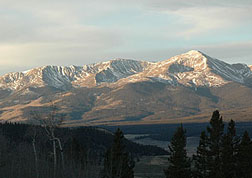 Linda and I hike a lot in Colorado, where we live, and also in Utah, as well as other places. We have seen a lot of Colorado over the years. We knew where to go. The process of finding our land took about four years and a lot of driving. We found an old development located at 10,000 feet and above. It had the aspens and the big view. Our lot came on the market the day before we got there. We bought it. That sounds easy, but you have to remember all that driving I mentioned above.
Linda and I hike a lot in Colorado, where we live, and also in Utah, as well as other places. We have seen a lot of Colorado over the years. We knew where to go. The process of finding our land took about four years and a lot of driving. We found an old development located at 10,000 feet and above. It had the aspens and the big view. Our lot came on the market the day before we got there. We bought it. That sounds easy, but you have to remember all that driving I mentioned above.
What was the impact of living in the cabin as you were doing the work? Did that experience change your view of necessity versus overall design?
This cabin was built on a tight budget. That meant that I was planning do most of the finish work, that it would not be done on a schedule, that the work would be improvised, and that I would use a lot of recycled materials. I also wanted the place to feel different, to have a foreign feel. The materials, the improvised techniques, the embrace of vernacular architecture and the live-and-work schedule all combined to make that happen.
Living in the cabin while working on it was thus a necessity. But it also had the benefit of allowing one to appreciate every accomplishment separately. No task goes unappreciated. After years of black plastic vapor barrier, the spruce planks walls were exhilarating. After years of strand-board floors, the oak flooring was delicious. I made a boot bench earlier this year, and it was a cause for celebration; the boot bench received a lot of attention then as well as during subsequent visits.
In your mind, did the cabin eventually take on a life and energy of its own?
Yes, fairly early on. I planned as I went. So the cabin was always suggesting something for me to think about and solve. If I awoke in the middle of the night, I'd likely find myself figuring out how to do some task in the cabin that I'd never done before.
Did your obvious creativity in design also lead you to use tools in ways beyond how a specific tool might normally be used?
Creativity is always called upon. But it was constraint that guided the choice of tools and how to use them. Since I did not have space for a workshop, and since I was trying to avoid spending all my money on wonderful new tools, I did not use some of the more obvious ones. I have no table saw nor chop saw at the cabin. The loose style encouraged by the wiggly form of the dead aspen trees and my adoption of vernacular forms also permits me to avoid the need for many tools that would be required for proper, precise craftsmanship. So I improvise constantly. I have used the bandsaw for all kinds of cutting tasks.
The freedom from perfect craftsmanship was another benefit. My work in the city includes a lot of perfect craftsmanship in graphic design. It was a pleasure to execute the looser, improvised carpentry in the cabin.
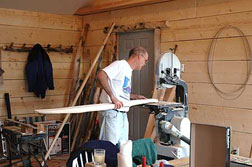 Was there a certain tool that you could not have gotten by without?
Was there a certain tool that you could not have gotten by without?
My ultimate tool is the bandsaw. It is still in the main room. It is amazing how broadly useful it is.
You mentioned in your email how helpful Highland's
Wood Slicer
resawing bandsaw blade was in finishing the cabin. Can you fill us in a little on how it helped?
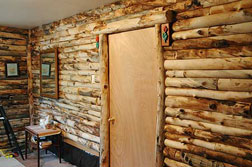 My primary usage was in resawing dead aspen trees to
make my window and door trim and also the wall covering
of aspen "tiles" in one of the bedrooms.
My primary usage was in resawing dead aspen trees to
make my window and door trim and also the wall covering
of aspen "tiles" in one of the bedrooms.
But I also use it for just about every other saw task for which
a 7" width is not a limitation (something often overcome by
precutting with a skilsaw.) I have limited space, since the
saw still lives in the main room of the cabin; so I have never
gotten a table saw. This has not been a problem because
the cabin's trim is designed around the dead aspen, which
is very wiggly.
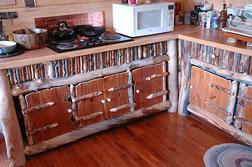 I've used it to cut materials for the kitchen cabinets.
I've used it to cut materials for the kitchen cabinets.
I use it to reduce the ends of logs and twigs before applying my
fancy tenon cutters.
I've used it cutting the irregular-shaped doors of the kitchen
cabinets (and the cardboard templates used to shape those
wiggly-edged doors.)
I've used it to prepare twigs for the twig-faced cabinet doors,
and to trim the edges of the twig-face boards.
I also use it in making some of my
sculptures
.
I love my Wood Slicer and am grateful to Marty Stevenson
for telling me about the blade and Highland Woodworking.
Could you go further into the "How Buildings Learn" theory and give some examples?
The idea comes from Stewart Brand (creator of the
Whole Earth Catalog
). He wrote a book called
How Buildings Learn.
In it he describes the long-term process by which buildings change through usage. In the case of our cabin, I am referring to a building process which evolves. Instead of having a professional builder turn over a finished product, which we then simply use, we took over a very functional building that was missing a lot of its parts. We then lived in it and decided what kind of walls, what kind of floors, and what kind of materials we would want to live with. We're still making decisions and the building is not finished in all its detail. Thus the building learns.
What are some examples of things that were tried and later abandoned?
I inherited a neighbor's cloth-remnants collection. We hung large pieces of it over the black plastic vapor barrier as a way of humanizing the space until we could get to the wall coverings. But it looked too sloppy. I also tried milling my own planks with the bandsaw and some of the dead aspen. I concluded it would take way too long to do it that way.
In looking at some of your paintings, I noticed that you use red lines to accentuate features frequently. I also noticed that you utilized similar techniques for certain features such as the stair rails, the glyphs and much of the trim of the exterior. Where do you draw that from?
I am an artist, a designer and a student of the history of art and architecture. My visual forms are a synthesis of many things I have seen. The use of color in the cabin will evolve. First comes the use of red, inside and out; the unity of the red parts ties things together. My secondary color systems will come later. I plan to paint transparent color into the interior doors. And I am adding color in the fridge-side upper cabinets in the form of diamond shapes made of bottle caps.
Much like cubism makes use of continuous imagery, it appears you did a similar thing except you relied on texture and color shades. Could you expand on the use of you color palate and texture as you selected the materials that you included in the cabin?
The base of the color/texture system is the wood: spruce, dead-aspen, fir, pine-twig, and oak. The texture variations were as-is, rough-cut, and varnished. Colors are added in two variations: solid (as in the case of the red parts) and tints (watered-down paints that are air-brushed on, revealing the wood grain; there is relatively little of this thus far, but I have imagined using this technique in various places.)
Did the look and feel of the various seasons that you experienced during construction impact or influence your decision making?
No. But I did enjoy their contrasts. I made most of the exterior railings outdoors on a big temporary work table. That was a delightful way to work: cold air, warm sun, and the big views waiting to surprise me when I happened to look up from my work.
For more photos and descriptions of John Boak's unique cabin project, please visit his
website
.